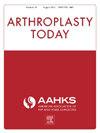慢性抗凝与初次全膝关节置换术后医疗并发症、假体周围关节感染和翻修率显著增加相关
IF 2.1
Q3 ORTHOPEDICS
引用次数: 0
摘要
背景:接受全膝关节置换术(TKA)的患者服用慢性抗凝(CA)的比例正在增加。由于现有文献有限,本研究的目的是比较接受和未接受ca的患者在原发性TKA后的并发症发生率。方法:采用IBM MarketScan数据库进行回顾性队列研究。根据TKA前后6个月内直接口服抗凝剂、华法林或低分子肝素的要求,将原发性TKA患者分为CA组或对照组。再入院率、90天内的医疗并发症、假体周围关节感染(PJI)和2年后的全因翻修率进行多变量logistic回归比较。结果共有181,760例患者符合纳入标准,其中CA组13967例(7.7%)。在第90天,CA组脓毒症发生率显著升高(0.9 vs 2.2%;优势比(OR) 1.7;P & lt;.001),血肿(0.3 vs 0.7%;或1.7;P & lt;.001),伤口开裂(1.2 vs 2.1%;或1.4;P & lt;.001),再入院率(6.1% vs 14.2%;或2.5;P & lt;措施)。2年后,PJI比率(0.4 vs 1.1%;或2.4;P & lt;.001)和全因修订(2.3 vs 3.4%;或1.5;P & lt;.001)显著高于CA队列。结论sca与原发性TKA后再入院、医疗并发症、PJI和全因翻修率显著升高相关。这一数据强调了术前医疗优化和围手术期医疗管理在这一人群中的重要性。本文章由计算机程序翻译,如有差异,请以英文原文为准。
Chronic Anticoagulation is Associated With Significantly Increased Rates of Medical Complications, Periprosthetic Joint Infection, and Revision After Primary Total Knee Arthroplasty
Background
The proportion of patients undergoing total knee arthroplasty (TKA) who are on chronic anticoagulation (CA) is increasing. As existing literature is limited, the purpose of this study was to compare complication rates after primary TKA among patients who were vs were not on CA.
Methods
This is a retrospective cohort study using the IBM MarketScan databases. Patients who underwent primary TKA were dichotomized into the CA or control cohort based upon the presence or absence, respectively, of claims for direct oral anticoagulants, warfarin, or low-molecular-weight heparin within 6 months both before and after TKA. Rates of readmissions, medical complications within 90 days, periprosthetic joint infection (PJI), and all-cause revision at 2 years were compared with multivariable logistic regression.
Results
A total of 181,760 patients met inclusion criteria, including 13,967 (7.7%) on CA. At 90 days, the CA cohort exhibited significantly higher rates of sepsis (0.9 vs 2.2%; odds ratio (OR) 1.7; P < .001), hematoma (0.3 vs 0.7%; OR 1.7; P < .001), wound dehiscence (1.2 vs 2.1%; OR 1.4; P < .001), and readmission (6.1 vs 14.2%; OR 2.5; P < .001). At 2 years, rates of PJI (0.4 vs 1.1%; OR 2.4; P < .001) and all-cause revision (2.3 vs 3.4%; OR 1.5; P < .001) were significantly higher in the CA cohort.
Conclusions
CA was associated with significantly higher rates of readmission, medical complications, PJI, and all-cause revision after primary TKA. This data highlights the importance of preoperative medical optimization and perioperative medical management in this population.
求助全文
通过发布文献求助,成功后即可免费获取论文全文。
去求助
来源期刊

Arthroplasty Today
Medicine-Surgery
CiteScore
2.90
自引率
0.00%
发文量
258
审稿时长
40 weeks
期刊介绍:
Arthroplasty Today is a companion journal to the Journal of Arthroplasty. The journal Arthroplasty Today brings together the clinical and scientific foundations for joint replacement of the hip and knee in an open-access, online format. Arthroplasty Today solicits manuscripts of the highest quality from all areas of scientific endeavor that relate to joint replacement or the treatment of its complications, including those dealing with patient outcomes, economic and policy issues, prosthetic design, biomechanics, biomaterials, and biologic response to arthroplasty. The journal focuses on case reports. It is the purpose of Arthroplasty Today to present material to practicing orthopaedic surgeons that will keep them abreast of developments in the field, prove useful in the care of patients, and aid in understanding the scientific foundation of this subspecialty area of joint replacement. The international members of the Editorial Board provide a worldwide perspective for the journal''s area of interest. Their participation ensures that each issue of Arthroplasty Today provides the reader with timely, peer-reviewed articles of the highest quality.
 求助内容:
求助内容: 应助结果提醒方式:
应助结果提醒方式:


